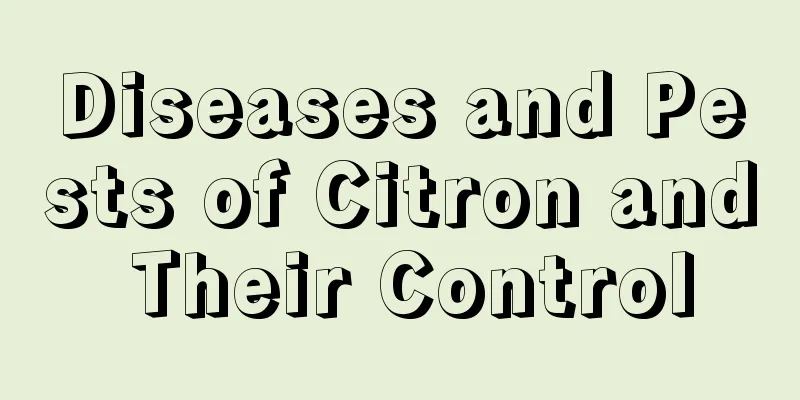Diseases and Pests of Citron and Their Control

Diseases of Buddha's HandSooty Disease of Buddha's HandOnce Buddha's hand is infected with sooty mold, the leaves of the plant will be damaged, and coal-gray spots will appear on the leaves. Over time, they will turn black, engulfing the entire leaf and hindering growth. Prevention and control of sooty disease: pay attention to ventilation, grow in a sunny place, also pay attention to regular drainage, and prune withered and damaged branches and leaves. You can use 1000 times diluted 40% Lecithin EC or 1:1:10 tobacco lime water to spray on the leaves for prevention and control, or you can use 1000-1500 times diluted 25% Juncarb EC to spray on the leaves for prevention and control of anthracnose. Citrus canker of bergamotIf the branches of Buddha's hand are damaged in a high temperature and high humidity environment, it is easy to cause citrus canker disease. This disease is a fungal virus that can significantly damage the tender new branches and leaves of Buddha's hand. Prevention and control methods: You can use drugs to spray for treatment. Start spraying with 0.5% Bordeaux liquid, agricultural streptomycin, etc. at the end of spring. When new leaves grow from late summer to early autumn, unfold the leaves and spray about 3 times a day. You can also directly eliminate the source of the disease and cut off the infected branches and leaves to prevent it from spreading to other healthy branches and leaves. Pests of Buddha's HandThe main pests of bergamot are leaf miners,. Cotton-blowing scale insect pests, aphids, and red spiders. Leaf miner pests on Buddha's handThe leaf miner pest of Buddha's hand will devour and damage the leaves of Buddha's hand, hindering photosynthesis and limiting the growth of the plant. In severe cases, the branches and leaves may rot and fall off, causing the entire plant to die. Prevention and control methods: The method to prevent and control leaf miners is to spray 1000 times diluted 90% crystal dichlorvos. Scale insect pests of Buddha's handThe cottony scale insect pest of Buddha's hand can damage the branches and leaves. Prevention and control methods: You can cut off the diseased parts to prevent infection. Mix the medicine with water, i.e. 1000 times of 40% dimethoate emulsifiable concentrate or 1000 times of 25% phosphite emulsifiable concentrate, and spray it. Aphids and red spider pests on Buddha's handAphids and red spider mites of Buddha's hand can cause damage to new branches and leaves. Prevention and control methods: The most effective prevention and control method is to spray with 1000-1500 times diluted triazolin. Pay attention to the concentration used. Too concentrated will cause unnecessary pesticide damage, which will not be worth the loss. |
<<: Diseases and their control of roses
>>: Diseases and Pests of Miniature Coconut Tree and Their Control
Recommend
How to make succulent bonsai
Glass ball bonsai making Material preparation Soi...
How long does it take for osmanthus to survive after transplanting?
1. How long can you survive? After transplanting ...
What's wrong with the root rot of Christmas cactus? What medicine should I use for the root rot of Christmas cactus?
1. What happens if the roots rot? 1. Too much wat...
The main role and function of trace element fertilizer (what are trace element fertilizers)
What is trace element fertilizer? Trace element f...
The advantages and disadvantages of Beatrice roses. What are the colors and re-flowering properties of Beatrice roses?
Beatrice is one of the representative varieties o...
How to dwarf black pine
1. Bend the main branches Generally speaking, it ...
Common varieties of lipstick flowers
Lipstick flower It is also called big red hairy m...
Gooseberry care methods and pest control
How to care for gooseberries Soil selection for g...
How to propagate green radish by cuttings and hydroponics
1. How to take cuttings 1. Flower soil: The flowe...
How often should green beans be watered?
The root system of green beans is very developed,...
How to water the green treasure tree
Watering tips for green treasure trees The Green ...
Breeding methods and precautions of Luanfeng Jade
form The top of the Luanfeng Jade is short and po...
How did the Thousand Buddha Hands explode?
1. Choose the right soil Thousand Buddha's Ha...
How to take care of the peace tree best
Peace tree growing conditions The peace lily like...
What kind of soil is good for growing peace trees?
1. What kind of soil should be used 1. When choos...









